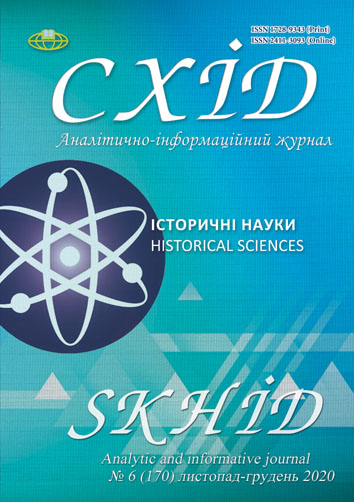HISTORICAL-THEORETICAL AND PRACTICAL PRINCIPLES OF APPLICATION OF DISCRETIONAL POWERS OF THE PRESIDENT OF UKRAINE
DOI:
https://doi.org/10.21847/1728-9343.2020.6(170).219877Keywords:
President of Ukraine, discretionary powers, functions of the President, Constitution, pollsAbstract
The introduction of the presidency is of great importance for the historical development of Ukraine as a sovereign, independent, democratic and legal state, as the consolidation of the President's position at the legislative level testifies to the international experience of democratic institutions, the main place among which is occupied by the presidency. The Constitution of Ukraine provided great opportunities for the President as a representative of the "interests of the whole people" to remain the dominant element of the political system of Ukraine. The powers of the President, in contrast to the powers of many other bodies and officials of the state, are provided exclusively at the level of the Constitution of Ukraine, and their expansion through ordinary laws is not allowed. The latter determine only the procedure for exercising a particular authority of the President of Ukraine in a particular sphere of public life. And this week it is very interesting to study a separate function of the President, namely the ability to act "in the spirit of the law (Constitution)" - discretionary powers. Many decisions and drafts of heads of state see discretionary powers, and this does not mean that there is an excess of power or even going beyond the law. After all, in the legal encyclopedia, dis-cretionary powers are defined as the right of the head of state, head of government, and other officials of public authorities to act under certain conditionsat their own discretion within the law. Discretion in a particular situation is indicated in the rule of law by such appeals as, for example, "may", "has the right", and not "should", "must". In the recent history of Ukraine, during the transformation of the institution of the presidency, we have already seen the exercise of their discretion by the heads of state. For the most part, we must mention the resonant decisions "in the spirit of the Constitution" of V. Yushchenko and P. Poroshenko. Thus, we will consider the poll of the President of Ukraine V. Zelensky, conducted on October 25, 2020, from the standpoint of his exercise of his discretion, namely the right to act based on his legal status, which is primarily defined in Article 102 of the Constitution of Ukraine, where it is written that "the President of Ukraine is the head of state and acts on its behalf."Downloads
References
George, A. A. (2020). President of India – Discretionary Powers You Never Knew Existed! ClearIAS.com Retrieved from https://www.clearias.com/president-india-powers-roles/
Kostytska, I.O. (2003). Instytut prezydentstva v Ukrayini: stanovlennya i funktsionuvannya. Teoretyko-pravovyy analiz. Kyiv: Institute of Legislative Predictions and Legal Expertise: 63 – 64 (In Ukrainian).
Malyshko, M.I. (2003). Prezydent Ukrayiny: konstytutsiyno-pravovyy status. Кyiv: UNA (In Ukrainian)
McGregor, J. (1994). The Presidency in East Central Europe. RFR/RL Research Report. 3 (2): 12–16.
O'Donnell, G. (1994). Delegative Democracy. Journal of Democracy. 5 (1): 55
On the legal opinion on the discretion of the President of Ukraine in issuing decrees enacting decisions of the National Security and Defense Council of Ukraine (2017, Mars 03). Plenum of The Supreme Administrative Court Of Ukraine. Decree. № 6. Retrieved from https://zakon.rada.gov.ua/laws/show/v0006760-17#Text (In Ukrainian)
Plahotniuk, N. (1998). Povnovazhennya Prezydenta Ukrayiny yak osnovnyy element instytutu prezydent•stva v Ukrayini. Bulletin of the Ukrainian Academy of Public Administration, 1 (In Ukrainian)
Shatilo, V.A. (2004). Instytut Prezydentstva v systemi derzhavnoyi vlady Ukrayiny. Kyiv: Ukr. tsentr polit. Menedzhmentu (In Ukrainian)
Shugart, M.S., Carey, J.M. (1992). Presidents and Assemblies. Constitutional Desagn and Electoral Dynamics. Cambridge: Cambridge University Press.
Siegan, Bernard H. (1994). Drafting a constitution for a nation or republic emerging into freedom. George Mason University Press.
Singh, M.P. (2017). Discretionary Powers of the President and Governors in India in Constitution and Practice. Indian Journal of Public Administration. 63(3): vii-xviii. doi:10.1177/0019556117721847
The Constitution of Ukraine (1996). Adopted at the 5th session of the Verkhovna Rada of Ukraine on June 28, 1996. Кyiv: Yurinkom, 1996. (In Ukrainian).
Tikhomirova, L., Tikhomirov, M. (2006). Pravovaya encyclopedia. (5 Edition) (In Russian)
Todyka, Yu.N. (1999). Osnovy konstitutsionnogo stroya Ukrainy. Kharkov: Fact, 203 – 208 (In Russian)
Yadav, Н.С., Gautam, Sunita (2017, September 19). Discretionary Powers of the President and Governors in India in Constitution and Practice: A Select Bibliography. Indian Journal of Public Administration. 63(3): 523-534. doi:10.1177/0019556117720976
Zadorozhnya, G. (2013) Dyskretsiyni povnovazhennya hlavy derzhavy. Visnyk Taras Shevchenko National University of Kyiv. Legal Sciences. 95: 77-80 (In Ukrainian).
Zelinska, M. (2010). Etapy transformatsiyi instytutu prezydent•sva v Ukrayini. Politychnyy menedzhment. 1: 68-75 (In Uktainian).
Zelinska, M. (2011). Indeksnyy analiz prezydentskoyi vlady za Konstytutsiyeyu Ukrayiny. Viche. 18: 9-12.
Zelinska, M. (2017). Institute of presidency within the concept of "failed state". In: Problems and prospects for the development of public administration in terms of reform. Bielsko-Biala: Higher School of Economics and Humanities, 164-177 (In Ukrainian).
Downloads
Published
How to Cite
Issue
Section
License
Copyright (c) 2020 Maryna Zelinska, Anna Chechel, Anna Zorina

This work is licensed under a Creative Commons Attribution-NonCommercial-NoDerivatives 4.0 International License.
1. Authors bear responsibility for the accuracy of facts, quotations, numbers and names used.
2. Manuscripts are not sent back.
3. The publisher does not always agree with the authors' opinion.
4. The authors reserve the right to authorship of the work and pass the first publication right of this work to the journal under the terms of a Creative Commons Attribution-NonCommercial-NoDerivatives 4.0 International License. This license allows others to distribute (copy) the published work for non-commercial purposes, provided there is mandatory attribution to its authors and a link to the first publication in our journal.
5. The authors have the right to conclude separate supplement agreements that relate to non-exclusive work distribution in the form in which it has been published by the journal (for example, to upload the work to the online storage of the journal or publish it as part of a monograph), provided that the reference to the first publication of the work in this journal is included.

